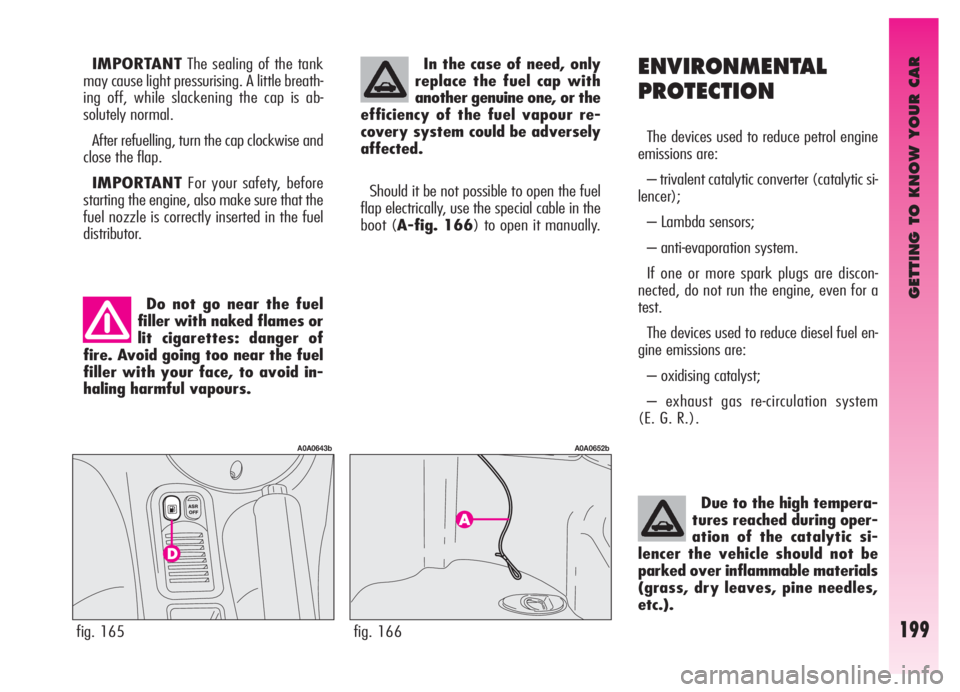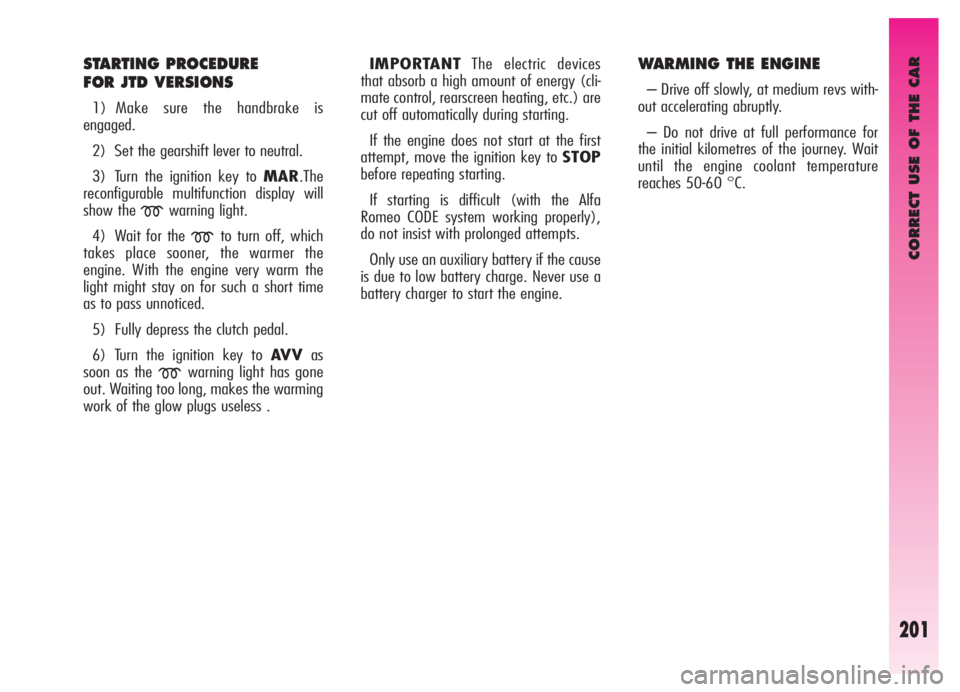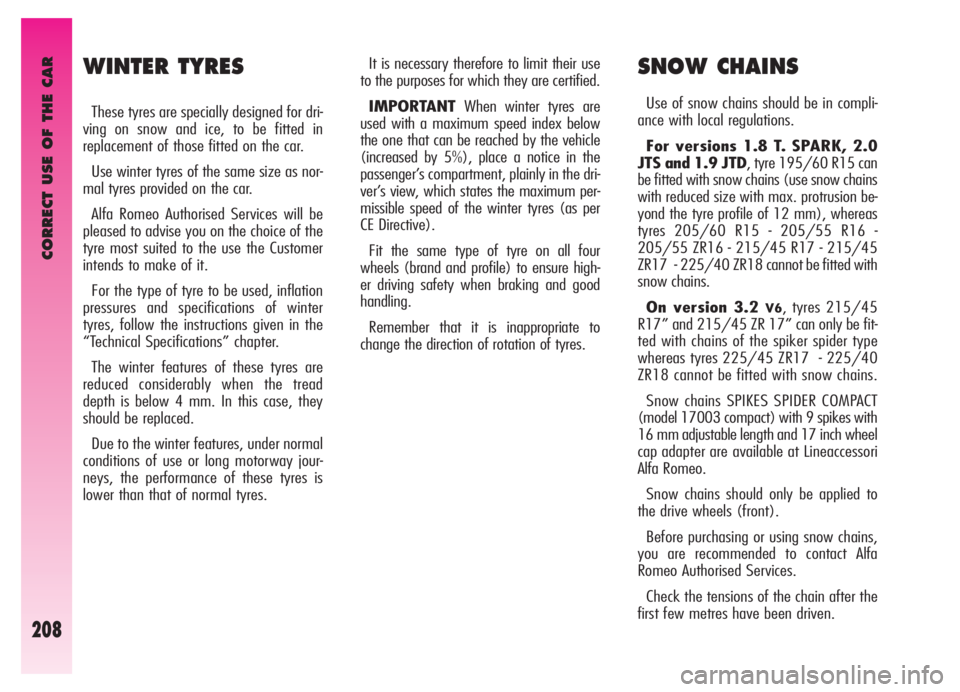Alfa Romeo GT 2005 Owner handbook (in English)
Manufacturer: ALFA ROMEO, Model Year: 2005, Model line: GT, Model: Alfa Romeo GT 2005Pages: 307, PDF Size: 6.05 MB
Page 201 of 307

GETTING TO KNOW YOUR CAR
199
ENVIRONMENTAL
PROTECTION
The devices used to reduce petrol engine
emissions are:
– trivalent catalytic converter (catalytic si-
lencer);
– Lambda sensors;
– anti-evaporation system.
If one or more spark plugs are discon-
nected, do not run the engine, even for a
test.
The devices used to reduce diesel fuel en-
gine emissions are:
– oxidising catalyst;
– exhaust gas re-circulation system
(E. G. R.). Do not go near the fuel
filler with naked flames or
lit cigarettes: danger of
fire. Avoid going too near the fuel
filler with your face, to avoid in-
haling harmful vapours.
In the case of need, only
replace the fuel cap with
another genuine one, or the
efficiency of the fuel vapour re-
covery system could be adversely
affected.
Should it be not possible to open the fuel
flap electrically, use the special cable in the
boot (A-fig. 166) to open it manually.
Due to the high tempera-
tures reached during oper-
ation of the catalytic si-
lencer the vehicle should not be
parked over inflammable materials
(grass, dry leaves, pine needles,
etc.).
fig. 165
A0A0643b
fig. 166
A0A0652b
IMPORTANTThe sealing of the tank
may cause light pressurising. A little breath-
ing off, while slackening the cap is ab-
solutely normal.
After refuelling, turn the cap clockwise and
close the flap.
IMPORTANTFor your safety, before
starting the engine, also make sure that the
fuel nozzle is correctly inserted in the fuel
distributor.
Page 202 of 307

CORRECT USE OF THE CAR
200
STARTING PROCEDURE
FOR PETROL VERSIONS
IMPORTANTIt is important never to
press the accelerator before the engine
has started.
1) Make sure the handbrake is engaged.
2) Move the gear lever to neutral.
3) Fully depress the clutch pedal, so that
the starter motor is not forced to crank the
gears.
4) Ensure that the electric systems and
devices, especially if they absorb high
quantities of energy (e.g. heated
rearscreen), are switched off.
5) Turn the ignition key to the AV V
position and release it as soon as the
engine starts.
6) If the engine does not start, return
the key to STOP,then repeat the proce-
dure.
IMPORTANTIf it is difficult to start
the engine do not insist with extended
attempts which may damage the catalyst,
but contact Alfa Romeo Authorised
Services. The ignition switch is fitted with a safety
device which obliges the driver to return
the key to the STOPposition before
repeating the starting operation if the
engine does not start immediately.
Similarly, when the engine is running,
the device prevents the key being moved
from the MARto the AV Vposition.
STARTING
THE ENGINE
IMPORTANTThe car is fitted with an
electronic engine lock device. If the engine
fails to start, see the “Alfa Romeo CODE
system”.
C C
O O
R R
R R
E E
C C
T T
U U
S S
E E
O O
F F
T T
H H
E E
C C
A A
R R
We recommend that dur-
ing the initial period you
do not drive to full vehicle
performance (for example exces-
sive acceleration, long journeys
at top speed, hard braking etc.).
Running the engine in
confined areas is
extremely dangerous. The
engine consumes oxygen and
produces carbon monoxide which
is a highly toxic and lethal gas.
When the engine is
switched off never leave
the ignition key in the
MAR position to prevent point-
less current absorption from
draining the battery.
Page 203 of 307

CORRECT USE OF THE CAR
201
STARTING PROCEDURE
FOR JTD VERSIONS
1) Make sure the handbrake is
engaged.
2) Set the gearshift lever to neutral.
3) Turn the ignition key to MAR.The
reconfigurable multifunction display will
show the
mwarning light.
4) Wait for the
mto turn off, which
takes place sooner, the warmer the
engine. With the engine very warm the
light might stay on for such a short time
as to pass unnoticed.
5) Fully depress the clutch pedal.
6) Turn the ignition key to AV Vas
soon as the
mwarning light has gone
out. Waiting too long, makes the warming
work of the glow plugs useless .IMPORTANTThe electric devices
that absorb a high amount of energy (cli-
mate control, rearscreen heating, etc.) are
cut off automatically during starting.
If the engine does not start at the first
attempt, move the ignition key to STOP
before repeating starting.
If starting is difficult (with the Alfa
Romeo CODE system working properly),
do not insist with prolonged attempts.
Only use an auxiliary battery if the cause
is due to low battery charge. Never use a
battery charger to start the engine.
WARMING THE ENGINE
– Drive off slowly, at medium revs with-
out accelerating abruptly.
– Do not drive at full performance for
the initial kilometres of the journey. Wait
until the engine coolant temperature
reaches 50-60 °C.
Page 204 of 307

Never push, tow or
coast start the vehicle.
This could cause fuel to
flow into the catalyst damaging
it irreversibly.
Remember that the
engine brake and power
steering are not opera-
tional until the engine is started,
therefore, much greater effort
than usual is needed on the brake
pedal and steering wheel.CORRECT USE OF THE CAR
202
For cars with tur-
bocharger in particular,
but for all cars in general,
sharp accelerating should be
avoided before switching the
engine off.
A “kick” on the accelerator
serves no purpose, consumes fuel
pointlessly and may cause seri-
ous damage to the turbocharger
impeller bearings.EMERGENCY STARTING
If the Alfa Romeo CODE system does not
recognise the code transmitted by the igni-
tion key (warning light
Yon the instru-
ment cluster glowing on steadily) emer-
gency starting may be carried out using
the code of the CODE card.
For the correct procedure see the chapter
“In an emergency”.
IMPORTANTIf the engine turns off
with the vehicle on the move, the next
time it is started, the Alfa Romeo CODE
warning light may turn on(
Y). In this
case, check that switching off and starting
the engine again with the vehicle station-
ary, the warning light stays off. If not, con-
tact Alfa Romeo Authorised Services.
ENGINE SWITCHING OFF
– Release the accelerator pedal and wait
until the engine reaches idle speed.
– Turn the ignition key to the STOP
position and switch off the engine.
IMPORTANTAfter a tiring journey it is
advisable to let the engine “get its breath
back” allowing it to idle a while to lower
the temperature in the engine compart-
ment.
Page 205 of 307

Never leave children
unattended in the vehicle.
Always remove the igni-
tion key when leaving the vehicle
and take it with you.To avoid useless con-
sumption of power and
possible draining of the
battery, never leave the ignition
key in the MAR position when
the engine is not running.
CORRECT USE OF THE CAR
203
PARKING
When the vehicle is parked, proceed as
follows:
– Switch off the engine.
– Engage the handbrake.
– Engage first gear if the vehicle is faced
uphill or reverse if the vehicle is facing
downhill.
– Turn the front wheels so that the vehi-
cle will immediately come to a halt if the
handbrake slips.
REDUCING RUNNING
COSTS AND
ENVIRONMENT
POLLUTION
By following a few simple guidelines, it
is possible to save vehicle running costs
and reduce harmful emissions.
GENERAL CONSIDERATIONS
Vehicle maintenance
To take care of the car maintenance
have the checks and adjustments carried
out in accordance with the “Scheduled
Maintenance Programme”.
Tyres
Check the pressure of the tyres routinely
at an interval of no more than 4 weeks: if
the pressure is too low consumption levels
increase as resistance to rolling is higher.
Useless loads
Never travel with an overload in the
boot. The weight of the vehicle (especial-
ly in urban traffic), and its geometry heav-
ily affect consumption levels and stability.Electric services
Use electric devices only for the amount
of time needed. Rearscreen heating, addi-
tional headlights, windscreen wipers and
heater fan need a considerable amount of
energy, therefore increasing the require-
ment of current increases fuel consump-
tion (up to +25% in the urban cycle).
Climate control system
The climate control system is a further
load bearing heavily on the engine induc-
ing higher consumption levels(up to
+20% on average). Outside temperature
permitting, preferably use the air vents.
Aerodynamic items
The use of non-certified aerodynamic
items may adversely affect air drag and
consumption levels.
Page 206 of 307

CORRECT USE OF THE CAR
204
CONDITIONS OF USE
Cold starting
Short journeys and frequent cold starts
do not allow the engine to reach optimum
operating temperature. This results in a
significant increase in consumption levels
(from +15 to +30% on the urban cycle)
and emission of harmful substances.
Traffic situations and road
conditions
Rather high consumption levels are tied
to situations with heavy traffic, for exam-
ple in queues with frequent use of the
lower gears or in cities with many traffic
lights. Also winding mounting roads and
rough road surfaces adversely affect con-
sumption.
Stopping in the traffic
During prolonged stops (e.g. level cross-
ings) it is advisable to switch the engine
off.
DRIVING STYLE
Starting
Do not warm the engine with the car at
a standstill or at idle or high speed: under
these conditions the engine warms up
much more slowly, increasing electrical
consumption and emissions. It is therefore
advisable to move off immediately, slow-
ly, avoiding high speeds. This way the
engine will warm faster.
Pointless manoeuvres
Avoid accelerating when waiting at traf-
fic lights or before switching off the
engine. This and also double declutching is
absolutely pointless on modern cars and
also increase consumption and pollution.
Gearshifting
As soon as the conditions of the traffic
and road allow, use a higher gear.
Using a low gear to obtain brilliant per-
formance increases consumption.
In the same way improper use of a high
gear increases consumption, emissions
and engine wear.Top speed
Fuel consumption considerably increases
with speed. Maintain an even as possible
speed, avoiding superfluous braking and
accelerating, which cost in terms of both
fuel and emissions.
Acceleration
Accelerating heavily taking the engine to
a high speed has a considerably adverse
effect on consumption and emission lev-
els; it is wise to accelerate gradually and
not exceed the maximum torque.
Page 207 of 307

CORRECT USE OF THE CAR
205
TOWING TRAILERS
IMPORTANTS
For towing caravans or trailers the vehicle
must be fitted with a certified tow hook
and an adequate electric system.
Installation should be carried out by spe-
cialised personnel who release a special
document for circulation on the road.
Install any specific and/or additional
rearview mirrors as specified by law.
Remember that when towing a trailer,
steep hills are harder to climb, the braking
spaces increase and overtaking takes
longer depending on the overall weight.
Engage a lower gear when driving down-
hill, rather than constantly using the
brake.
The weight the trailer exerts on the vehi-
cle tow hook reduces by the same amount
the actual vehicle loading capacity. To make sure the maximum towable
weight is not exceeded (given in the log
book) account should be taken of the fully
laden trailer, including accessories and per-
sonal belongings.
Drive within the specific speed limit in
every country for vehicle trailers. In any
case the maximum speed should never
exceed 100 km/h.
INSTALLING THE TOW HOOK
The towing device should be fastened to
the body by specialised personnel accord-
ing to the following instructions and any
additional and/or integrative information
supplied by the Manufacturer of the device
itself.
The towing device must meet current
regulations with reference to Directive
94/20/CEE and subsequent amend-
ments.
For any version the towing device used
must match the towable weight of the
vehicle on which it is to be installed.
For the electric connection a unified con-
nector should be used which is generally
placed on a special bracket normally fas-
tened to the towing device itself. The ABS system with
which the car may be fit-
ted does not control the
trailer braking system. Particular
care is therefore necessary on
slippery surfaces.
Under no circumstances
should the vehicle brake
system be altered to con-
trol the trailer brake. The trailer
braking system must be fully
independent of the vehicle’s
hydraulic system.
Page 208 of 307

CORRECT USE OF THE CAR
206
For the electrical connection a 7 or 13
pole 12VDC connection must be used
(CUNA/UNI and ISO/DIN standards) fol-
lowing any reference instructions given by
the vehicle Manufacturer and/or towing
device Manufacturer.
Any electric brake should be supplied
directly by the battery through a cable
with a cross-section of no less than 2.5
mm
2. In addition to the electrical branch-
es, the vehicle electric system can only be
connected to the supply cable for an elec-
tric brake and to the cable for an internal
light, though not above 15W.INSTALLATION LAYOUT
(fig. 1)
The tow hook structure must be fas-
tened in the points shown by the
symbol Ø using 4 M8 screws and 7
M10 screws.
The inner plate (2) should have a
minimum thickness of 6 mm.
The inner plate (3) should have a
minimum thickness of 4 mm.
The inner plate (4) should have a
minimum thickness of 5 mm.
The fastening points (1) should be
fitted with 25 mm x 6 mm spacers.After assembly, the fas-
tening screw bores shall
be sealed to prevent pos-
sible exhaust gas infiltrations.
IMPORTANTIt is compulsory to fas-
ten a label (plainly visible) of suitable size
and material with the following wording:
MAX LOAD ON BALL 60 kg.
Page 209 of 307

CORRECT USE OF THE CAR
207fig. 1
A0A0680b
Existing holes
Existing holes
N°2 M10N°3 M10N°4 M8
Regulation ballN°2 M10
SEZ. A-A
Fully laden
Existing holes
Page 210 of 307

CORRECT USE OF THE CAR
208
It is necessary therefore to limit their use
to the purposes for which they are certified.
IMPORTANTWhen winter tyres are
used with a maximum speed index below
the one that can be reached by the vehicle
(increased by 5%), place a notice in the
passenger’s compartment, plainly in the dri-
ver’s view, which states the maximum per-
missible speed of the winter tyres (as per
CE Directive).
Fit the same type of tyre on all four
wheels (brand and profile) to ensure high-
er driving safety when braking and good
handling.
Remember that it is inappropriate to
change the direction of rotation of tyres. WINTER TYRES
These tyres are specially designed for dri-
ving on snow and ice, to be fitted in
replacement of those fitted on the car.
Use winter tyres of the same size as nor-
mal tyres provided on the car.
Alfa Romeo Authorised Services will be
pleased to advise you on the choice of the
tyre most suited to the use the Customer
intends to make of it.
For the type of tyre to be used, inflation
pressures and specifications of winter
tyres, follow the instructions given in the
“Technical Specifications” chapter.
The winter features of these tyres are
reduced considerably when the tread
depth is below 4 mm. In this case, they
should be replaced.
Due to the winter features, under normal
conditions of use or long motorway jour-
neys, the performance of these tyres is
lower than that of normal tyres.
SNOW CHAINS
Use of snow chains should be in compli-
ance with local regulations.
For versions 1.8 T. SPARK, 2.0
JTS and 1.9 JTD, tyre 195/60 R15 can
be fitted with snow chains (use snow chains
with reduced size with max. protrusion be-
yond the tyre profile of 12 mm), whereas
tyres 205/60 R15 - 205/55 R16 -
205/55 ZR16 - 215/45 R17 - 215/45
ZR17 - 225/40 ZR18 cannot be fitted with
snow chains.
On version 3.2
V6, tyres 215/45
R17” and 215/45 ZR 17” can only be fit-
ted with chains of the spiker spider type
whereas tyres 225/45 ZR17 - 225/40
ZR18 cannot be fitted with snow chains.
Snow chains SPIKES SPIDER COMPACT
(model 17003 compact) with 9 spikes with
16 mm adjustable length and 17 inch wheel
cap adapter are available at Lineaccessori
Alfa Romeo.
Snow chains should only be applied to
the drive wheels (front).
Before purchasing or using snow chains,
you are recommended to contact Alfa
Romeo Authorised Services.
Check the tensions of the chain after the
first few metres have been driven.